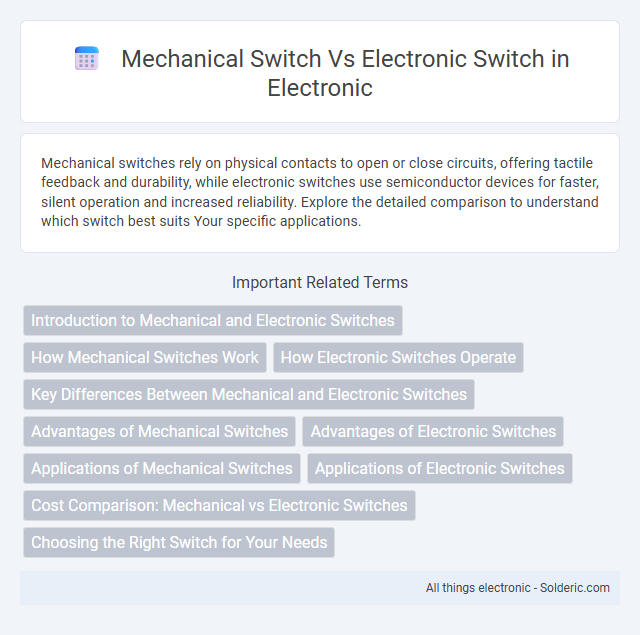Mechanical switches rely on physical contacts to open or close circuits, offering tactile feedback and durability, while electronic switches use semiconductor devices for faster, silent operation and increased reliability. Explore the detailed comparison to understand which switch best suits Your specific applications.
Comparison Table
| Feature | Mechanical Switch | Electronic Switch |
|---|---|---|
| Operation | Physical movement to open/close circuit | Uses semiconductor devices to control current flow |
| Speed | Slower switching (milliseconds) | Faster switching (nanoseconds to microseconds) |
| Durability | Limited mechanical lifespan (millions of cycles) | High reliability, long lifespan (no mechanical wear) |
| Size | Bulkier due to physical components | Compact and lightweight semiconductor design |
| Power Consumption | Generally low, no power in open state | May consume power even when on or off depending on type |
| Noise | Audible clicking sound | Silent operation |
| Applications | Household switches, relays, industrial controls | Microcontrollers, power electronics, digital circuits |
| Cost | Generally lower initial cost | Potentially higher initial cost, but efficient for complex use |
Introduction to Mechanical and Electronic Switches
Mechanical switches operate through physical contact points that open or close a circuit, providing tactile feedback and reliable performance in applications like keyboards and power controls. Electronic switches, such as transistors and MOSFETs, control current flow using semiconductor properties, offering faster switching speeds and greater efficiency in modern electronics. Choosing between mechanical and electronic switches depends on factors like durability, response time, and the specific requirements of the device or system.
How Mechanical Switches Work
Mechanical switches operate through physical movement, where pressing the switch causes metal contacts to touch and complete an electrical circuit. These switches are valued for their tactile feedback, durability, and reliable performance in devices like keyboards and industrial equipment. Your choice between mechanical and electronic switches depends on the need for responsiveness, longevity, and user experience.
How Electronic Switches Operate
Electronic switches operate by controlling the flow of electrical current through semiconductor components such as transistors, FETs, or MOSFETs, enabling rapid and precise switching without mechanical movement. These switches rely on voltage or current signals to turn on or off, modulating circuits at high speeds with minimal wear and virtually silent operation. Electronic switches excel in applications requiring fast switching times, low power consumption, and enhanced reliability compared to mechanical switches.
Key Differences Between Mechanical and Electronic Switches
Mechanical switches rely on physical moving parts to open or close electrical circuits, providing tactile feedback and durability often preferred in gaming keyboards and industrial machinery. Electronic switches, such as transistors or solid-state relays, operate without moving components, offering faster switching speeds, lower power consumption, and greater reliability in electronic devices and automation systems. Your choice depends on application requirements like response time, longevity, and environmental conditions.
Advantages of Mechanical Switches
Mechanical switches offer superior tactile feedback and durability, making them ideal for applications requiring precise control and long-term reliability. Their physical actuation ensures consistent performance even in harsh environments, unlike electronic switches that may be susceptible to electrical noise or signal interference. Choosing mechanical switches can enhance your device's responsiveness and lifespan, especially in industrial or high-use settings.
Advantages of Electronic Switches
Electronic switches offer faster switching speeds and greater precision compared to mechanical switches, enabling improved performance in high-frequency and complex circuits. Their lack of moving parts leads to enhanced durability and longer operational lifespan while minimizing wear and tear. You benefit from lower power consumption and reduced electrical noise, making electronic switches ideal for modern, energy-efficient applications.
Applications of Mechanical Switches
Mechanical switches are widely used in applications requiring reliable physical feedback and durability, such as industrial machinery, automotive controls, and home appliances. Their tactile response and ability to operate in harsh environments make them ideal for heavy-duty equipment and manual control panels. You will often find mechanical switches in devices where precise actuation and robustness are critical for safety and functionality.
Applications of Electronic Switches
Electronic switches are widely used in applications requiring fast, reliable, and precise control of electrical circuits, such as in computers, telecommunications, and power management systems. Solid-state relays and transistors serve as electronic switches in devices like power supplies, signal modulators, and automated industrial controls, offering advantages in durability and switching speed over mechanical counterparts. Your choice of an electronic switch can enhance system performance in environments demanding high-frequency switching and minimal mechanical wear.
Cost Comparison: Mechanical vs Electronic Switches
Mechanical switches generally have lower upfront costs due to simpler design and widespread manufacturing, making them cost-effective for basic applications. Electronic switches, such as MOSFETs or transistors, typically incur higher initial expenses because of advanced materials and integrated circuit requirements but offer greater efficiency and longevity. Long-term cost analysis often favors electronic switches by reducing maintenance and energy consumption despite their higher initial investment.
Choosing the Right Switch for Your Needs
Mechanical switches offer tactile feedback, durability, and reliability, ideal for applications requiring physical confirmation and high endurance, such as industrial machinery and heavy equipment. Electronic switches provide faster response times, compact design, and energy efficiency, making them suitable for modern electronics and automation systems. Assessing factors like load capacity, switching speed, environmental conditions, and maintenance requirements ensures selecting the right switch tailored to specific operational needs.
mechanical switch vs electronic switch Infographic

 solderic.com
solderic.com